Why gooseberries turn yellow and dry in summer and what to do with this
Gooseberry is one of the most unpretentious berry bushes on our backyards. It easily takes root anywhere in the garden, rarely gets sick and bears fruit abundantly for years. But, despite its self-sufficiency, the plant sometimes gets sick and suffers from insect pests. What to do if the gooseberries began to turn yellow and wither, we will tell you in this article.
The content of the article
Why gooseberries turn yellow and dry in summer
If at the height of summer on the gooseberry and its close relative the currants turned yellow for no apparent reason, began to curl, dry up and fall off the leaves, it is time to take immediate action.
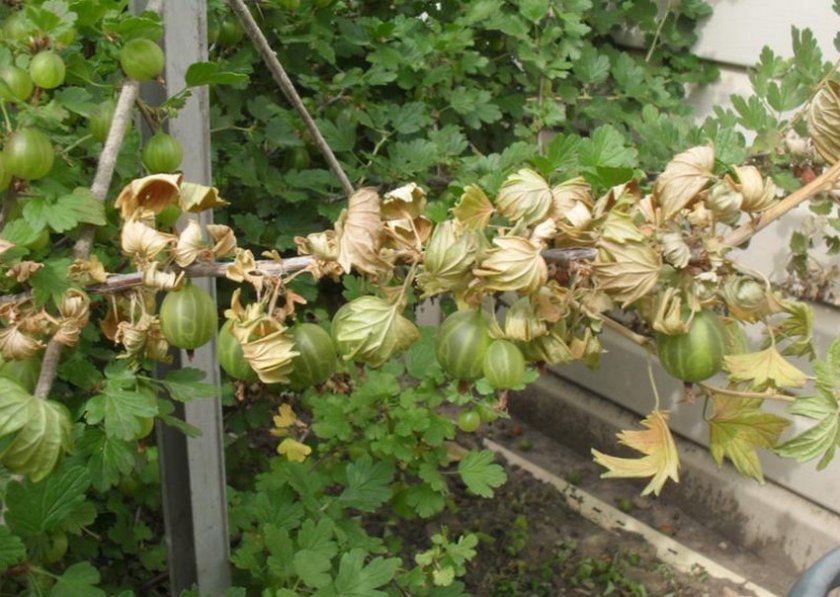
Leaves turn yellow and fall
If the gooseberry leaves turn yellow in June, it may be short of water. Abundant (at least 20 liters) watering the bush at the root will help to solve the problem.
When the gooseberry stagnates, the upper leaves grow dull and shallow, and the lower leaves turn yellow, curl and fall off, the bush blooms prematurely and gives a poor harvest, possibly the shrub grows on acidified soil and is clogged with weeds... In this case, the plant needs weeding and spring feeding with nitrogen-containing fertilizers: ammonium nitrate, urea and carbamide, ammonium sulfate, ammonium sulfate.
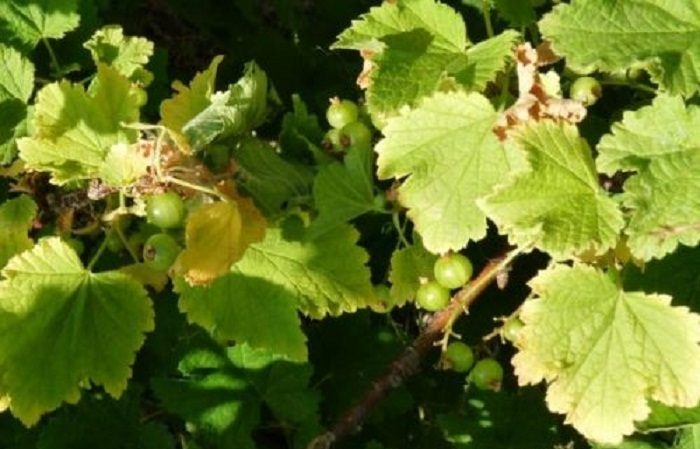
Gooseberries, like any plant, can get sick:
- If a white cobweb appears on young foliage and the tops of the shoots, which gradually grows, thickens and becomes like felt, this is mycelium with powdery mildew spores, or gooseberry spheroteca... The disease progresses with high soil moisture and hot weather (18 to 30 ° C).
- If at the beginning of summer on leaves and berries were seen gray-brown or reddish spots with a yellow rim, by August the leaves have fallen off, and the growth of shoots has noticeably decreased, which means that the plant is infected white spot, or gooseberry septoria.
- Another fungal disease - anthracnose - identified by rounded brown spots on both sides of the leaf. The disease progresses during the rainy season in mid-summer.
- Gooseberry rust Is a fungal disease. If the bush is in sedge thickets, orange seals may appear on the leaves, flowers and ovaries - goblet rust. If small yellowish spots are visible on the upper side of the leaf, yellow-orange growths are visible on the lower side, and conifers grow somewhere nearby (for example, cedar or pine), then symptoms of columnar rust are observed.
Gooseberries and pests are affected:
- Gooseberry shoot aphid green, very small, so it is not easy to detect. The insect infects the leaves and young shoots of the bush, feeding on its juice. As a result, the leaves curl up, the shoots slow down growth, and sometimes die.
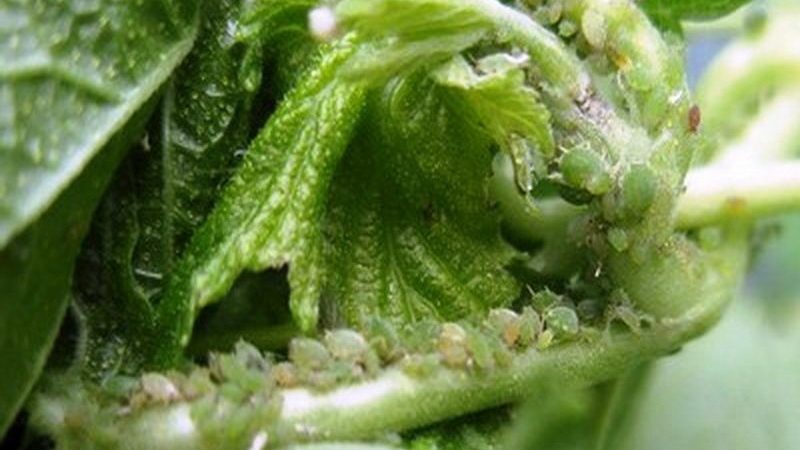 Gooseberry shoot aphid
Gooseberry shoot aphid - In early spring on blossoming leaves caterpillars attack... Eggs along the veins of the underside of the leaf can be laid by butterflies of the yellow or pale-legged gooseberry sawfly or gooseberry moth. One butterfly lays up to 150 eggs at a time, and several generations of pests grow over the summer.
- Butterfly currant glass lays eggs in the cracks in the bark of the plant. Its caterpillars feed on the core of the shoots, gnawing tunnels from the top to the bottom. From this, the damaged branches dry up and die.
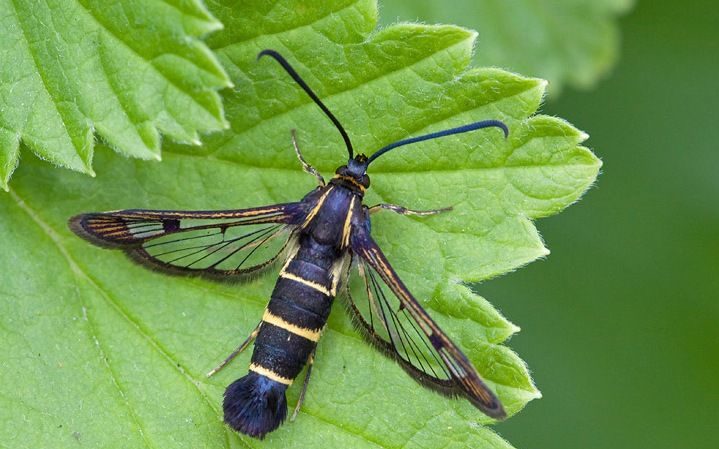 Butterfly currant glass
Butterfly currant glass - Currant gall midges they lay the larvae in the shoots, flowers and leaves of the gooseberry, which feed on them and destroy them. Insects infect bushes in too thick plantings.
- Currant kidney mite penetrates into the buds of the gooseberry and feeds on the juice of young leaves. Because of this, the kidneys look too large and ugly compared to healthy ones.
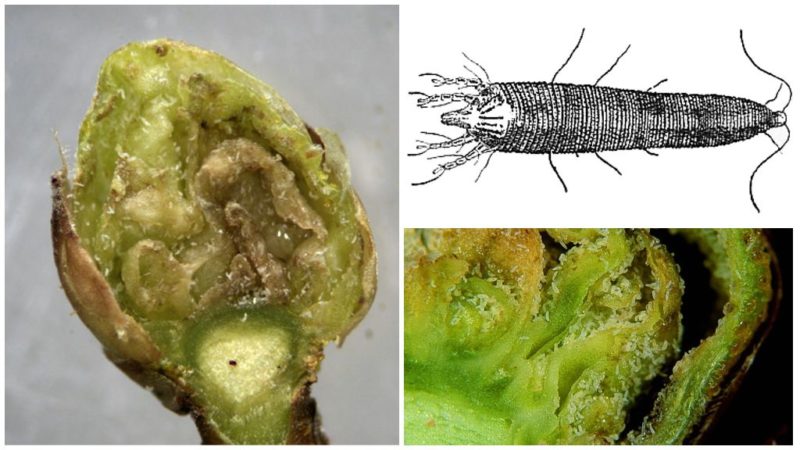 Currant kidney mite
Currant kidney mite
Berries are falling
The reason for the falling off of fruits, like leaves, may be drought, a deficiency of useful trace elements, a lack of sunlight.
Gooseberry diseases cause a lot of trouble for gardeners. Powdery mildew first affects leaves and young shoots, and then spreads to ovaries and berries. If the disease is started, the fruits develop poorly, darken and fall off. At the same time, the appearance of the shrub also suffers: the shoots are bent, the foliage of the gooseberry turns yellow and becomes wrinkled.
Insect pests do not disregard juicy gooseberry... The light green caterpillars of the gooseberry moth, which have grown in the flowers of the gooseberry, eat away the fruit ovary, enveloping it in cobwebs. The insect hurts throughout the season, but the second generation of caterpillars inflicts the greatest damage during the ripening period.
Sawfly caterpillars do not feed on fruits. However, in summer they eat almost all the leaves from the shrub, as a result of which the process of photosynthesis is disrupted, and the plant “gets rid” of the berries.
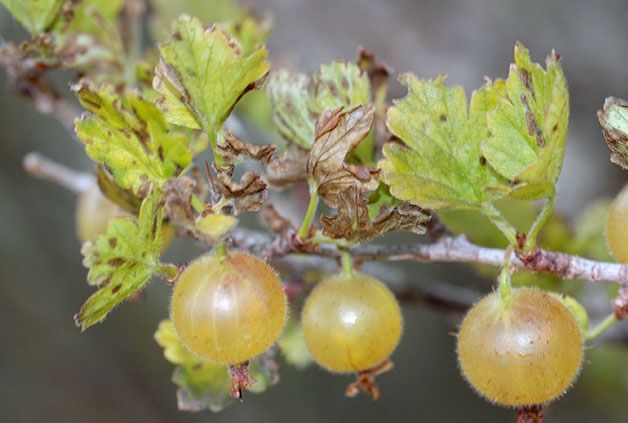
Young seedlings turn yellow
Often slow development gooseberry seedlings error related when choosing a landing site.
In excessively humid areas, where groundwater comes close to the surface, plants do not take root well and often get sick. The same can be said about the place in the shade: the leaves on such bushes are pale, the berries are few and small.
Another reason for the weakness of young shoots may be insufficient depth of the root collar during planting. The recommended depth should be at least 6-7 cm. If this rule is violated, the shoots will be thin and weak. They will not be able to form the basis of the future bush and give it the opportunity to fully develop.
Gooseberry care rules
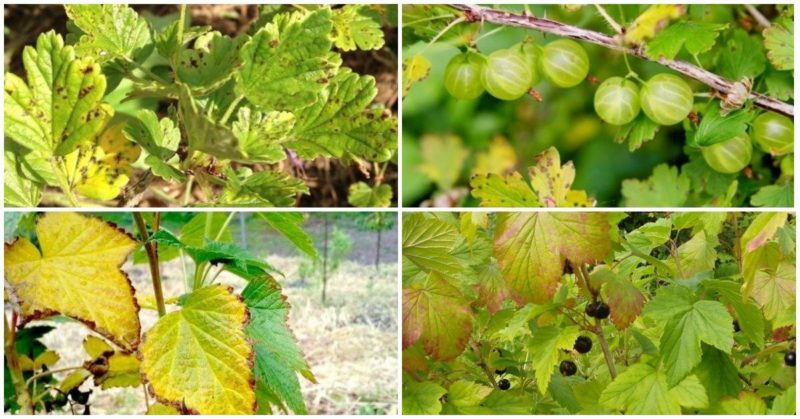
In order for the berry to please for years with juicy greens and a bountiful harvest, it must be properly looked after. The gardener does not require any special knowledge, skills or unique processing tools and plant nutrition.
A few simple tips gooseberry care in the spring-summer period:
- Every spring 3-5 strong, young shoots are left, the rest are cut off at the root. They also remove frozen, damaged and old, dried branches.
- From early spring, once every 2-3 weeks, the soil is shallowly loosened (up to 10-12 cm) in order to break the formed crust and remove weeds. The soil around the bush is mulched to retain moisture - one bucket of peat (or other organic matter) per bush.
- Gooseberries are watered abundantly three times per season. The first time is in late May - early June, when the ovary appears. The second - in the second half of June, during the formation and ripening of berries. At the end of September, moisture-charging watering is needed, which will help the roots of the plant to strengthen and prepare for winter.
- In the first 2 years, the young bush does not need fertilization. From the third year, it is watered with mullein diluted with water in a ratio of 1: 4. One bucket of mixture is enough per bush. Such dressing, introduced in the first half of June, will strengthen the plant during the ripening period of the berries. In the spring, before bud break, it is useful to feed the bushes with nitrogen fertilizers: 25 g of ammonium nitrate or 30 g of urea per 1 sq. m. Potassium-phosphorus fertilizers are applied only in autumn.
It is pointless to water gooseberries from a watering can and it is harmful from a hose: the earth is washed out from the base of the bush, and the root collar damp. According to the rules, you need to dig a hollow in a circle where the crown of the bush ends, and pour water into it.
Treatment of diseases
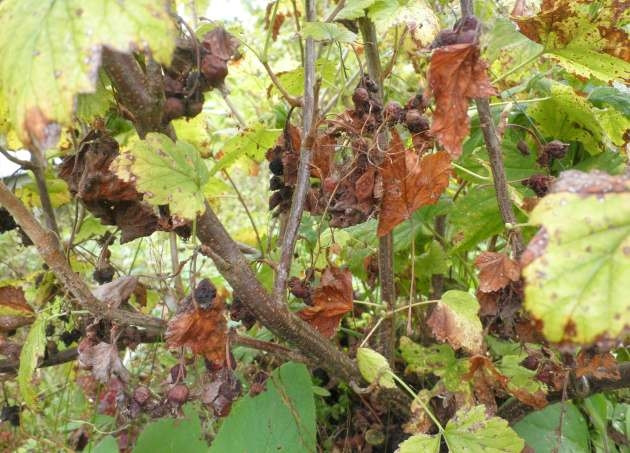
Having recognized the disease, you need to choose the right method of treatment:
- If signs of powdery mildew damage are noticed before the buds open, it is recommended to spray the bush with fungicides. If the symptoms of the disease appear during flowering or fruiting, the bush is irrigated twice with an interval of a week with a solution: 5 g of soda and 50 g of grated soap per 10 liters of water.Well proven in the fight against the disease "Fundazol", "Horus" and "Topaz".
- To combat gooseberry septoria, affected shoots cut off to healthy tissue, and the bush is treated with fungicides.
- In order to prevent and treat anthracnose, it is recommended to spray the bush and the soil around it with Nitrofen or 1% solution of copper sulfate (40 g per 10 l of water). If the disease is running, the plant is treated with Bordeaux liquid (100 g per 10 l of water) at least 4 times per season: before flowering, immediately after it, a couple of weeks after the second spraying and after harvesting. Also, to combat anthracnose and septoria, use "Khomycin", "Kuprozan", colloidal sulfur.
- To destroy rust, gooseberries are treated with a 1% solution of Bordeaux liquid or any other fungicide during the period when the leaves bloom, when buds appear and after flowering. To consolidate the result, one more irrigation is allowed no earlier than 10 days after processing the flowers.
To prevent the spread of diseases, the affected leaves and berries are carefully collected, the shoots are cut and burned.
Pest control
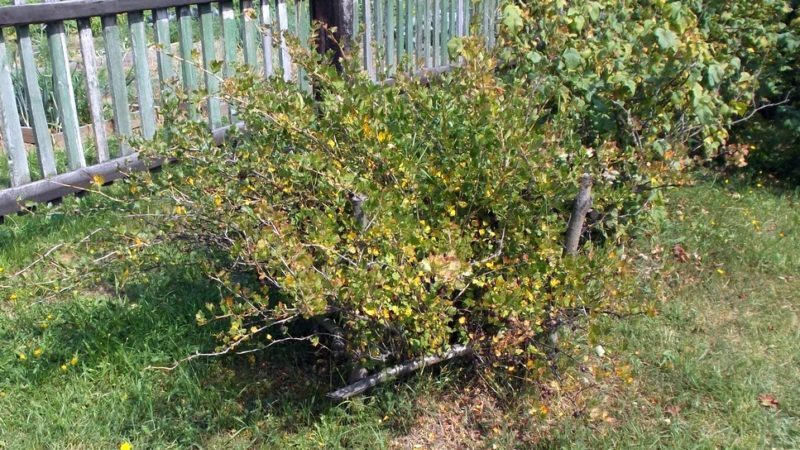
Experienced gardeners begin their fight against insects in the fall: they collect fallen leaves, cut off damaged shoots and burn them.
The soil is loosened and mulched. The bushes are treated with insecticides or folk remedies: infusion of onions, garlic, mustard or tobacco.
In the spring, when buds appear, the bush is treated against gall midges, aphids, currant glass and sawfly with an aqueous solution of "Karbofos" (75 g per 10 l of water) or "Rovikurt" (10 g per 10 l of water). Kidney mites are fought with a solution of colloidal sulfur at the rate of 30-40 g of the drug per 10 liters of water.
After flowering, gooseberries are sprayed with Karbofos or Aktellik.
Note! If there is an anthill on the site, aphids will appear on the gooseberry constantly. First of all, it is necessary to destroy not aphids, but ants.
Conclusion
It's easy to grow gooseberries in your garden. Choose a light, not too damp place, fertilize the ground before planting. For the first couple of years, do not disturb the plant, let it take root and grow stronger. Do not forget about prevention: carefully examine the leaves and stems, loosen the ground, heal and feed the bush with at least simple folk remedies.
Be sure that the gooseberry will thank you for your care and will delight you with a generous harvest for many years.